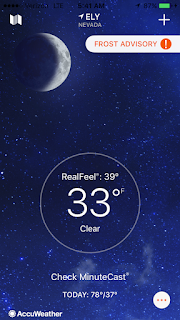Before I get to this day's log, I wanted to share with you some more pictures from our first day. Below are three pictures Dennis Gertenbach took of some very nice finds from day one's Crittenden Springs site.
For today's trip, we carpooled to Utah, towards Cowboy Pass. The air was not clear; like Colorado, there've been fires burning in Nevada. The wind was up and humidity was down, so smoke blew across mountains and valleys from north Nevada.
 |
| Robinson Ranch site |
The first stop, Robinson Ranch, was in a wide, dry wash, into which Carboniferous brachiopods and solitary corals were carried.
 |
| Searching the wash at the Robinson Ranch site |
We never became certain of the source rock, though we looked for it. While searching, I did find some interesting concretions to photograph. And Dennis found a curious lizard:
 |
| Rock art |
 |
| Click for larger to see Lizzie |
 |
| Holdfast? and branched solitary coral |
There was one side gully that was dubbed Coral Wash, as most of the corals were found there. One type had branching at a segment line which, according to Patrick, are distinctive to a very few species so we hope to get a good identification of them. The specimen to the right of this photo is this type of coral. The other piece in the photo is thought to be the holdfast of a crinoid.
The second stop of the day was also in west Utah, Bishop Springs. This particular locality was a lone mound in a wide open valley.
 |
| Bishop Springs site |
 |
| An eye-catching concretion |
The outcrops were covered with odd, blackened concretions. The concretion here was the first highly patterned one we passed.
In several places, there were fossils in slabs too big and hard to bring home - beautiful horn
corals, interesting brachiopods, and a lone gastropod. The brachiopods were on concretions we speculated might have been part of a burrow system.
 |
| Coral Slab |
 |
| Brachiopods (a few I circled) and possible burrows |
 |
| Gastropod |
The slab of horn corals pictured below shows an interesting story of preservation. Apparently the center of some of these will be replaced differently than the outer portion. The center is replaced with chert which is harder than the source rock. As the source rock is worn away, the chert is left exposed.
 |
| Interesting preservation of coral |
The final stop of the day was the Ward Charcoal Kilns. The kilns were used to burn wood into charcoal which was used in local smelters.
 |
| Ward Charcoal Kilns |
Since I didn't get to this blog last night and am writing this in the morning, the weather has cooled. I am glad I am in a motel:


















































